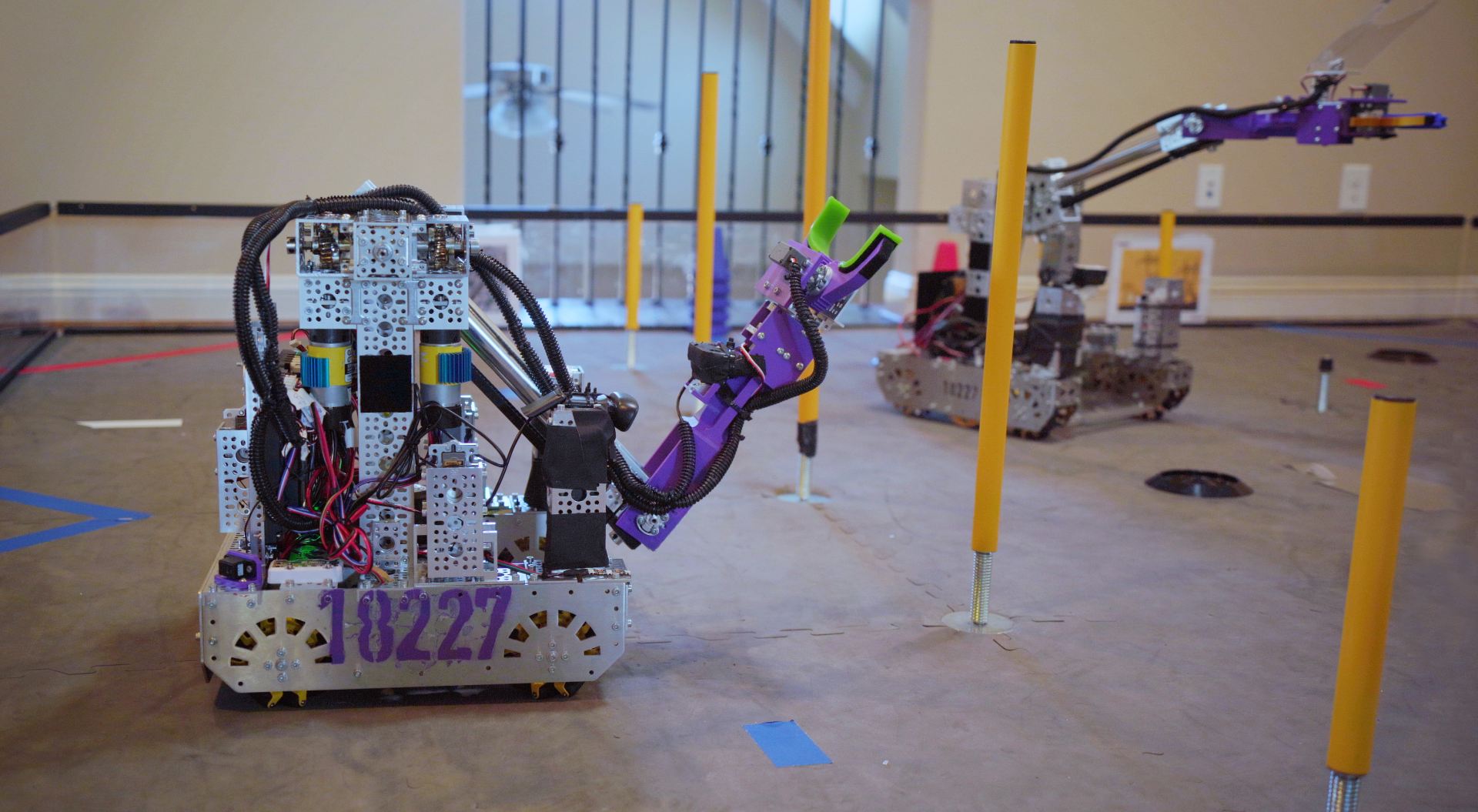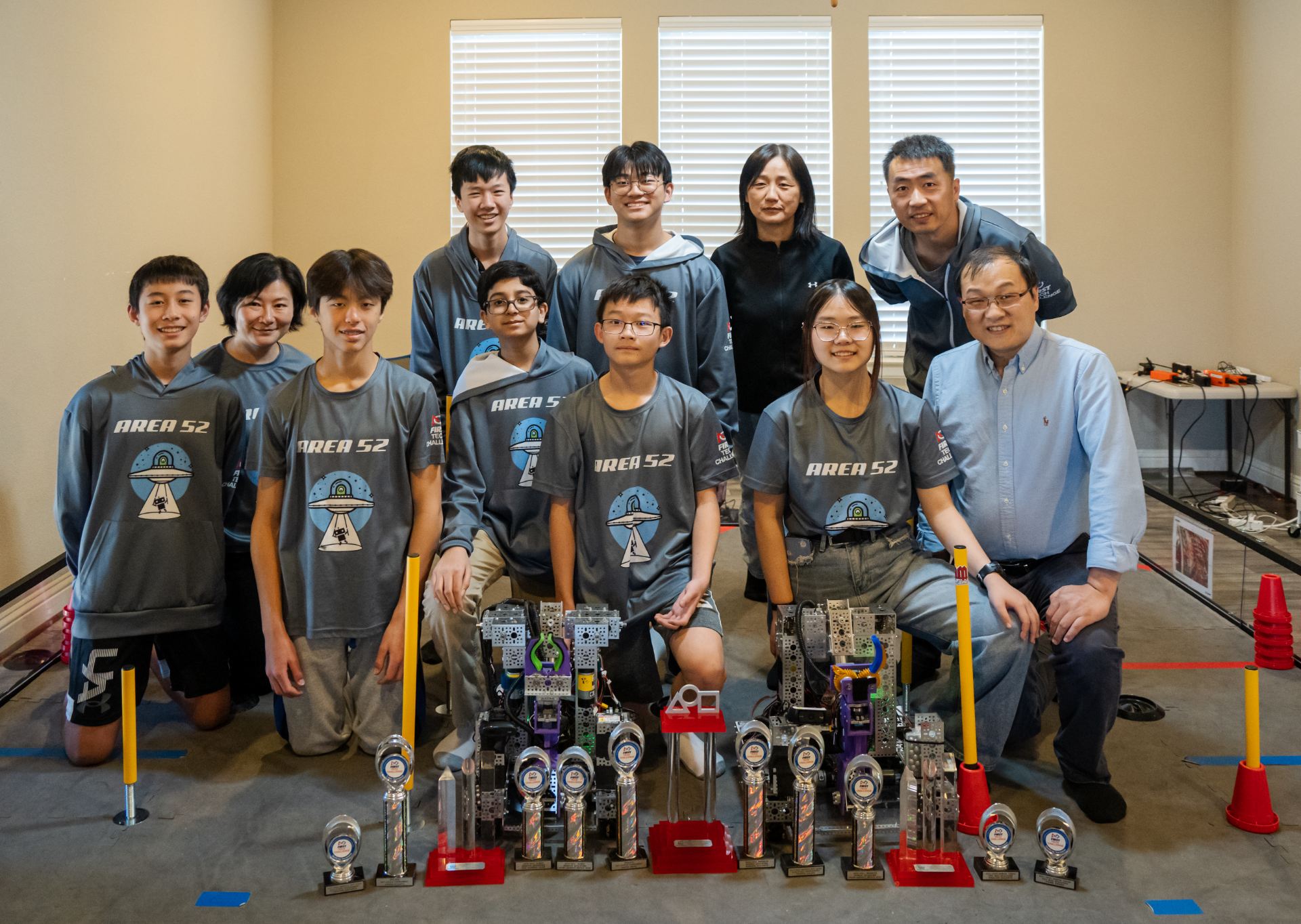by Caryn Berardi

Dr. Xiaoyan Shi is busy shaping the next generation of technology and science innovators — by day, as a professor and researcher, and in his spare time, as a robotics mentor in the local community.
Shi is an assistant professor in the Department of Physics. His research lab, known as the Quantum Transport Group, focuses on studying superconductors and other quantum materials in ultra-low temperature experiments. His lab achieved the lowest temperatures in North Texas — 10 miliKelvin, or about -459 degrees Fahrenheit.
In addition to his work in the rapidly growing quantum materials field, Shi coaches a robotics team of 14 middle and high school students. They compete in year-round tournaments at regional, state and global levels.
His team, called Area 52, is part of the FIRST organization, a STEM education non-profit organization that engages kids in various hands-on technology programs and teams. Participants have access to over $80 million in scholarships to colleges, universities and technical programs.
Area 52 is a FIRST Tech Challenge (FTC) team that teaches students to think like engineers. They design, build, program and drive robots in head-to-head matches against other groups.
Shi’s eighth-grade daughter, Amy, initially drew him to the opportunity.
“My daughter really likes robotics, and she was determined to join a team competition,” he said. “After we found her FTC team, I thought it was exciting and wanted to help them, so I quickly joined as a coach.”


One of 170 robotics teams in North Texas, Area 52 comprises students from Plano, Frisco, Allen, and McKinney. The team is currently No. 2 in North Texas teams and ranks No. 52 out of 6,000+ global teams. As a hardware coach, Shi focuses primarily on helping the students use computer-aided design (CAD) to build their robots.
“Students come in not knowing the mechanical principles behind robotics,” Shi said. “For example, if you design a robotic structure, how strong does it need to be? What gears and motors do you use? Through this program, they are learning advanced skills they can take into their future careers.”
FTC teams use dedicated control hubs and write code for the robots using Java-based programming. In each match, students are tasked with completing a specific challenge, such as getting the robot to pick up and drop cones over various targets.
Area 52 meets every Friday evening to strategize and spends Saturday afternoons building, training and field testing its robots to prepare for matches. The students have different group roles, such as hardware building, programming or driving the robots using joypads. They even install webcams into their robots for computer vision, such as OpenCV, and carefully calibrate their arm movements with advanced PID control algorithms, Shi said.
Shi coaches alongside other academic and business professionals from companies such as Ericsson, Photodigm, Fujitsu, Amazon, and IBM. These powerful relationships between the students and professional mentors are a core aspect of FIRST’s goal to enrich the lives of its students, according to Haley Morse, FIRST senior communications manager.
“Meaningful involvement of adults in children’s lives is proven as an essential component for developing young people’s potential,” Morse said. “We hope that the professionals who support FIRST students find renewed inspiration and understand the profound impact they have on shaping the lives — and career pathways — of young people.”


In addition to developing technical skills, Shi and his fellow coaches encourage the kids to hone their professional, interpersonal and communication skills. Since the team has limited resources, students are responsible for reaching out to companies to secure sponsorships and funds for team activities and outreach events.
Dr. Kyeongjae Cho, a professor in the Department of Materials Science and Engineering at UT Dallas, has a daughter in her second year on the Area 52 team. As one of the team’s mentors and volunteers, Cho has watched Sophie become more proactive in communicating with her own teammates and other robotics teams, as well as build her confidence to take on a leadership role.
“I am very impressed with the level of challenges given to the young students, and even more impressed with the teamwork to meet the engineering challenge during the tournaments,” Cho said. “Through the FTC experience, my daughter has developed a strong interest in STEM careers for her college and career directions.”
For Shi, mentoring is just one way that UT Dallas physics faculty can get involved in the community. He said he would love to see more guest speaking opportunities at schools, sharing resources with teachers and coaching school competitions.

Shi organizes on-campus tours for his team to experience UTD’s research facilities and introduce students to the NanoExplorers program, which he integrates into his lab’s summer research group. Cho said he plans to invite Area 52 to participate in a new robotic synthesis lab this summer, as well.
It is all part of the plan to give back and get young people excited about science.
“Every week, I see my students develop more problem-solving skills and bring new ideas to the team,” Shi said. “Our future depends on more students getting involved in STEM. Area 52 is empowering the next generation.”
Help us leave the planet a better place for future generations. Your support for the School of Natural Sciences and Mathematics funds scientific discoveries with real-world applications, student and faculty recruitment, and academic scholarships.